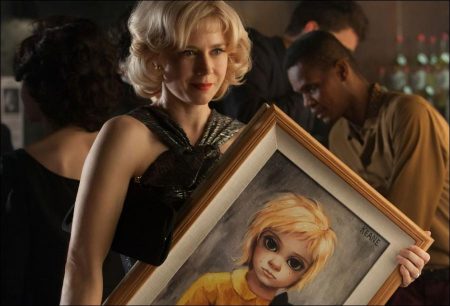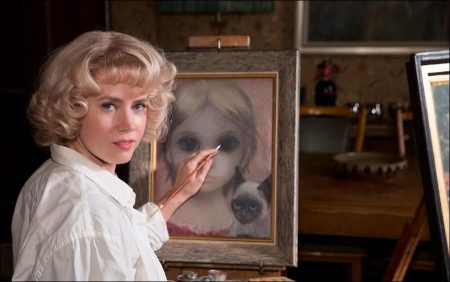From the whimsical mind of director Tim Burton, BIG EYES tells the outrageous true story of one of the most epic art frauds in history. In the late 1950s and early 1960s, painter Walter Keane had reached success beyond belief, revolutionizing the commercialization of popular art with his enigmatic paintings of waifs with big eyes.
The bizarre and shocking truth would eventually be discovered though: Walter’s works were actually not created by him at all, but by his wife Margaret. The Keanes, it seemed, had been living a colossal lie that had fooled the entire world. A tale too incredible to be fiction, BIG EYES centers on Margaret’s awakening as an artist, the phenomenal success of her paintings, and her tumultuous relationship with her husband, who was catapulted to international fame while taking credit for her work.
Big Eyes is a 2014 American biographical film directed by Tim Burton, starring Amy Adams and Christoph Waltz. The script was written by Scott Alexander and Larry Karaszewski. The film is about the life of American artist Margaret Keane—famous for drawing portraits and paintings with big eyes. It followed the story of Margaret and her husband, Walter Keane, who took credit for Margaret’s phenomenally successful and popular paintings in the 1950s and 1960s, and the lawsuit (and trial) between Margaret and Walter, after Margaret reveals she is the real artist behind the big eyes paintings.
Big Eyes had its world premiere in New York City on December 15, 2014.[4] It was released in theatre on December 25, 2014 in the U.S. by The Weinstein Company. The film was met with positive reviews, praising the performances of both Adams and Waltz. Adams won the Golden Globe Award for Best Actress – Motion Picture Comedy or Musical and was nominated for a BAFTA Award for Best Actress in a Leading Role. Waltz was also nominated for a Golden Globe Award for his performance and Lana Del Rey received a Golden Globe nomination for the film’s theme song “Big Eyes”.
About the Production
In 2003, writing partners Scott Alexander and Larry Karaszewski learned the stranger than fiction story of Margaret and Walter Keane, the top selling painters of the 1960s. Intrigued, they began to research a story that would take ten years to finally go into production.
“It’s a great piece of history that nobody knows,” says Alexander. “If it weren’t true, I wouldn’t believe it.”
“There were a lot of reasons why we wanted to make this movie,” says Karaszewski. “We thought Margaret was a great female character that embodied the beginning of the Women’s Movement. It starts with her as a 1950’s housewife who does everything for her husband. Through the course of the story, she learns to stand up for herself.” Alexander and Karaszewski have a tremendous track record with biopics, having written films about comedian Andy Kaufman (MAN ON THE MOON) and publisher Larry Flynt (THE PEOPLE VS. LARRY FLYNT) and producing one about actor Bob Crane (AUTO FOCUS).
“Scott and I are very attracted to these sorts of biographies of people who you initially didn’t think were important and who were marginalized.” He notes that ED WOOD, their first film with Tim Burton, “was about someone who people thought was the worst filmmaker of all time. And there are some people who think the Keanes are the worst painters of all time. We thought by making this film we could tell a very great personal story, as well as discuss issues of the art world and the Women’s Movement.”
The writers were spellbound by the Keane’s story. “Walter really invented the mass marketing of art,” says Karaszewski. “He wasn’t accepted in galleries and by art critics so he built his own galleries, put out his own coffee table books. He figured out how to make the paintings so cheap that the average man could buy them and he totally revolutionized the art world.
Certainly, people who came along later, like Peter Max or Thomas Kinkade, borrowed from his playbook, and even Andy Warhol acknowledges stealing a little bit from Walter Keane’s philosophy. But what’s amazing is the secret behind it all: the paintings were his wife’s and he manipulated her into letting him put his name on them and taking all the credit. We were totally fascinated and thought this was a great American story that hadn’t been told.”
The writers spent weeks at libraries and pouring through San Francisco newspaper stories in microfiche archives, trying to piece together the sensational tale of the Keanes. “It was hard to get a straight story,” says Alexander, and they set out to meet with Margaret. “We needed to be able to earn her trust and show that we had integrity.”
Keane agreed to a meeting and the writers flew up to her in San Francisco. “We had a really nice lunch,” says Alexander. “We asked the questions that the newspaper stories didn’t answer, which were: How did this happen? When was the first time Walter said he was the painter? What did he tell you? Why did you agree? And, as this went on for year after year after year, why did you continue to let him do this? Psychologically it didn’t make a lot of sense.
We started to understand though that she came out of a 1950’s housewife mentality where the man was in charge of the household and laid down the rules and, in fairness to Walter, he promised a lot of things that came true. He said they’d become famous, make a lot of money and live in a big house. Years later, Margaret still says that without Walter nobody ever would have discovered her art. She still gives him a lot of credit.”
Margaret Keane agreed to sell Alexander and Karaszewski the rights to her life as well as her art. “It took us one more year to work it out so Margaret would be comfortable,” Alexander says. “We didn’t want to do anything that was going to make her feel bad about the film. We had to earn her trust at all times.”
Today, Margaret is 86 years-old and lives an hour out of San Francisco. Walter died in 2000, several years before the screenplay began to take shape. Margaret says, “Scott and Larry were so enthusiastic and they really wanted to do it the same way that I did, so I really felt secure with them. I had already gotten four other offers and turned them down, which is very difficult to do, but I couldn’t trust what they would do so I said no.”
“They made it come alive,” Margaret says of Alexander and Karaszewski’s script. “They found humor and tragedy in it. It’s just marvelous. I feel like I’m being showered with blessings, having a movie. It’s such an honor, and really sort of a humbling thing because I don’t think I deserve this. I just paint and all of a sudden this is happening. It’s like a dream. It’s surreal.”
Margret and Tim Burton knew one another before a screenplay was even in the works. “Tim commissioned me to do portraits and then he bought several of my paintings. I couldn’t help but like him. I can’t imagine anyone better than Tim Burton directing this film.”
Keane makes a cameo appearance in the film in a scene filmed in San Francisco at the Palace of the Arts. “I was supposed to be a little old lady sitting on a bench, enjoying the day. It was so touching. Tim came over and handed me a little Bible and I thought to myself, ‘How kind he is – he knows how much I like the Bible so he gave me one to read while I was sitting there.’ It was a day I will always remember.”
While developing BIG EYES, the plan had been that Alexander and Karaszewski would also direct. In 2007, with a draft in hand, they set out to make the movie. “It seemed to have a black cloud floating over it,” says Alexander. “It almost got made several times, and it kept falling apart,” says Karaszewski. “But the smartest thing that Scott and I ever did was never sell it. In all those various versions, we maintained control. And it finally worked out.”
Having worked with Alexander and Karaszewski on ED WOOD and being a fan of Margaret’s art, Tim Burton came on board as producer early on. “Tim loves Margaret’s art,” says Alexander. “He identified with the idea of outsider art, and why does art have to be legitimized by what critics say. And that’s really what the movie’s about. The idea of outsider art, of primitivism art is what we did with Tim on ED WOOD and he really identifies with that, so it was always very close to him.”
Executive producer Derek Frey is a long-time collaborator of Burton’s and runs the filmmaker’s company. Frey says one of the reasons the Keane art resonated in America is that “It came at a time when art was at the forefront of society and maybe Keane art was a nice, comfortable introduction for mainstream society to enter into that world. You can’t have a kinder or more approachable subject than a child or a pet.”
Tim Burton grew up during the heyday of the Keanes and was familiar with the work. “Margaret was certainly someone that Tim was familiar with for a long time,” says Frey, “and he had such an interest in her art, he hired her to create a number of pieces for him, long before there was even talk of this project.”
In addition to being the filmmaker behind a slate of spectacular motion pictures, Tim Burton is also a noted visual artist. His own work and the unique look of his signature style were influenced by the paintings of Margaret Keane. “A lot of people have drawn parallels between her art and his,” says Frey, who edited the comprehensive and award-winning publication, “The Art of Tim Burton,” and worked closely with MOMA curators to create the recent Tim Burton exhibit that toured internationally.
“A lot of his characters have large disc eyes and that’s more than a coincidence. I think growing up it’s something that he gravitated towards. He found a connection to characters that have that certain look and the Keane art was definitely the first time that was ever seen in mass culture, so I think it must have had an impact on him.”
BIG EYES was a perfect vehicle for Burton. “People tend to associate Tim’s world and his work with darker subjects,” says Frey, noting that before the art exhibit, he was seen predominantly as a director, but now he is recognized as a visual artist as well.
explores the turmoil and a darker side of the art world and I think it’s something that even a handful of years ago might not have been right for Tim. But I feel like it’s a nice, mature next step in his career. It makes sense. He found it a challenge, and a welcome one. Coming off of some larger films in recent years, I think this is something that he was looking toward to bring him back to earth and back to his roots and beginnings. It isn’t visual effects-driven, but rather story and character-driven and I think that was something he welcomed. He hasn’t made a film of this budget or scale since “Pee Wee’s Big Adventure” and it excited him to be able to tackle a project like this at this point in his career. It was refreshing for him.”
“Tim always felt the role of Walter was one that would be particularly challenging,” says Frey, “because he’s not the most likeable character. It needed to be right.” Burton and Christoph Waltz, the actor recently lauded with Oscars for tour-de-force performances in Quentin Tarantino’s last two pictures, met during awards season in early 2013, and it was kismet. “Tim passed the script along to him and, immediately after reading it, Christoph called and said, “I love it, I get it, I’ll be in it – but only if you direct it.” Pretty much on the spot, Tim said, “okay.”
It was quite interesting how quickly this came together after many years of trying to get it off the ground. It really was with that connection with Christoph that Tim felt the pieces were coming together, and once he came into play, it didn’t take more than a few days and then we had Amy on board. It just seemed so perfect. I’ve never seen a film come together so quickly once that first role was put into place. Tim was excited by that and we couldn’t have dreamed of having such a duo as these two people together on one film. They’re so perfect for these roles.”
Big Eyes (2014)
Directed by: Tim Burton
Starring: Amy Adams, Christoph Waltz, Danny Huston, Jon Polito, Krysten Ritter, Jason Schwartzman, Terence Stamp, Madeleine Arthur
Screenplay by: Scott Alexander, Larry Karaszewski
Production Design by: Rick Heinrichs
Cinematography by: Bruno Delbonnel
Film Editing by: JC Bond
Costume Design by: Colleen Atwood
Set Decoration by: Craig Lewis
Music by: Danny Elfman
MPAA Rating: PG-13 for thematic elements and brief strong language.
Studio: The Weinstein Company
Release Date: December 25, 2014
Visits: 378






